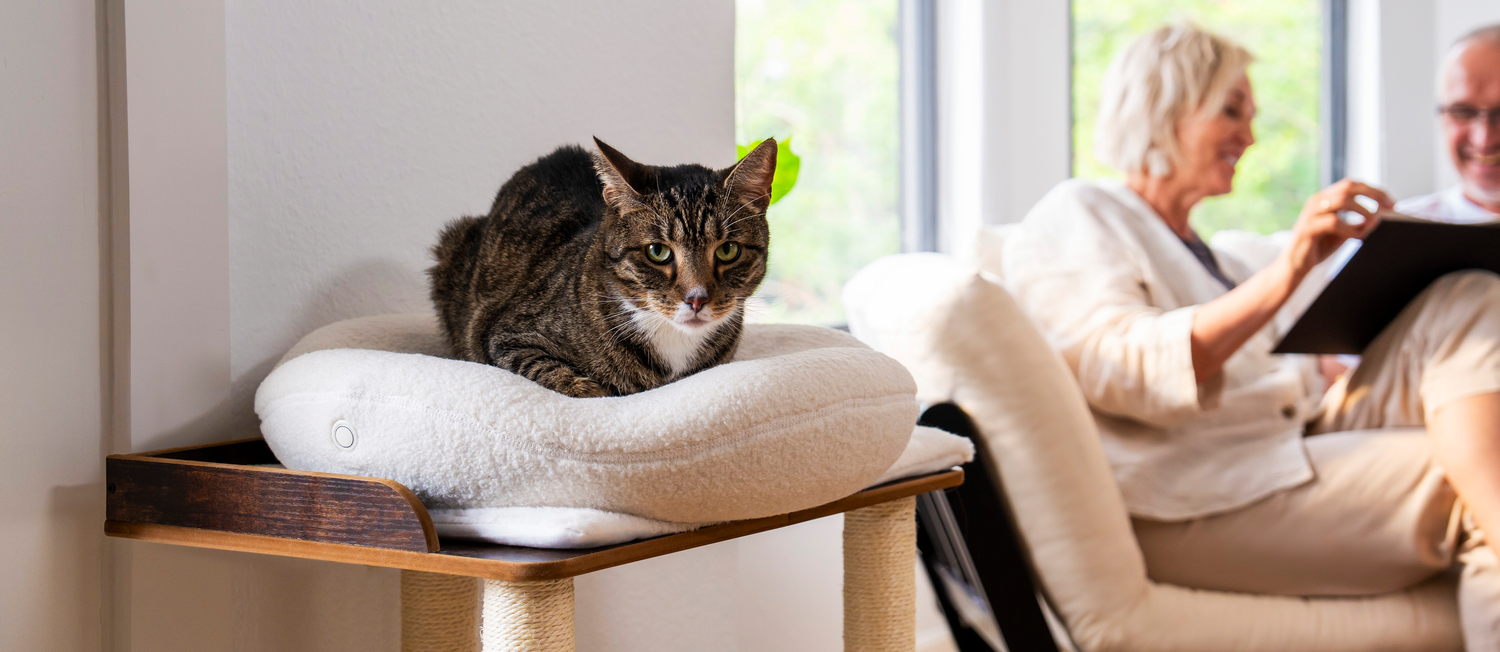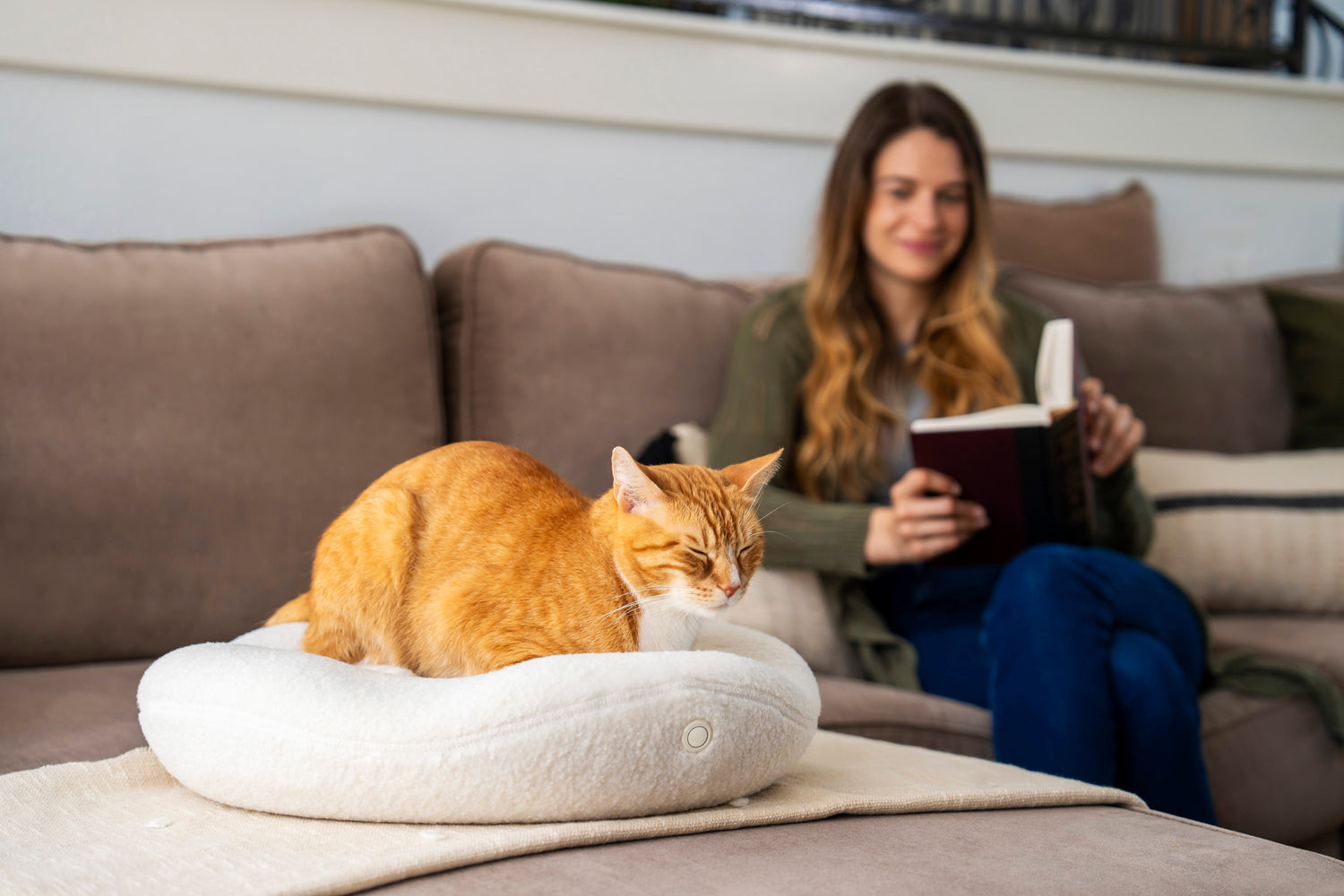Cats can’t talk — but even if they could, they wouldn’t tell you when they were in pain. Their instinct to hide discomfort makes it hard for pet owners to realize something’s wrong, especially with chronic conditions like arthritis. If you suspect your cat is developing sore joints, there are clues to watch out for, such as a reluctance to jump or a lack of desire for playtime.
We’ve asked a cat behavioral expert about the most common signs of arthritis in cats, along with simple ways to help improve symptoms at home — from using a mindfully-designed orthopedic heated cat bed to adding ramps for easier access to your cat’s favorite spots.
What is arthritis in cats?
Arthritis (also known as degenerative joint disease or osteoarthritis) is a chronic condition characterized by inflammation, pain, and stiffness in the joints. While it often develops with age, arthritis in cats can also be a result of a pre-existing condition, an injury, or obesity.
Why Do Cats Hide Their Pain?
Wild cats are solitary hunters, so they’re careful not to vocalize or show discomfort. (Otherwise, they’ll attract predators and competition for food.) Thus, when a cat in the wild is unwell or injured, it’ll wander off to a remote area.
Domestic cats act the same way, even if they’re not hunting for their meals. Pain is associated with weakness, so when your cat isn’t feeling its best, that instinct to hide will kick in. However, as we’ll explain below, there are telltale signs your cat will need some extra TLC or even a trip to the vet.
If your cat cries in pain, that’s an obvious indicator of a serious issue. Of course, every cat is different, so your best course of action is to pay attention to changes in your pet’s behavior, habits, and/or appearance.
Domestic cats nowadays maintain the instincts of their ancestors, making it difficult for their owners to detect when their cats are in pain. — Dr.Lingna Zhang, Cat Behaviorist & Researcher
What Are the Signs My Cat Has Arthritis?
Arthritis in cats is more common than you may think; research shows that 90% of cats aged 12 and over are afflicted by this degenerative condition 1.If your cat exhibits any of these behaviors, arthritis may be the cause. Below are the five most common signs your cat has arthritis:
-
Your Cat Limps or Has a Stiff Gait
The most obvious signs your cat has arthritis are limping and stiffness, especially after waking up from a cat nap. Pay attention to your cat’s sitting position, as well. Discomfort from sore joints may force your cat to sit with a hunchback or a paw slightly off the ground. -
Your Cat Avoids Jumps and Steps
Another indicator of arthritis in cats is a reluctance to jump to or from surfaces or go up and down steps, as these actions can further aggravate sore joints. This won’t stop every cat with arthritis from trying to navigate these areas, but they won’t stick the landings like they used to. -
Your Cat’s Behavior and Activity Levels Have Changed
Pay attention to your cat’s demeanor. Arthritis symptoms can make cats withdrawn, irritable, or even aggressive, especially when touched. Pay attention to your cat’s activity levels, too, as sore joints will limit their desire for play. Arthritis can affect your cat’s eating and drinking habits, as well, particularly if bowls are at an uncomfortable height or difficult to get to. -
Your Cat Has Trouble Using the Litter Box
Climbing in and out of the litter box and squatting to go to the bathroom will be painful for many cats with arthritis. As a result, your cat may start going to the bathroom outside of the litter box to avoid joint discomfort (or even an association with that discomfort). -
Your Cat Isn’t Self-Grooming (or is Grooming Too Much)
A cat with sore joints from arthritis might have trouble reaching areas that need grooming, leading to dull or matted hair. On the other hand, your cat might over-groom its painful joints, causing hair loss and sores in the affected areas.
Note: While the above can indicate arthritis in cats, these symptoms overlap with other underlying conditions. Visit your vet for a complete check-up and an official diagnosis with a custom treatment plan.
Early detection of arthritis in cats is key, as veterinarians can diagnose it through exams and imaging. — Dr. Lingna Zhang, Cat Behaviorist & Researcher
How to Care for Your Cat’s Arthritis at Home
In addition to your vet’s pain management plan — which may include medications, injections, and/or supplements — here are five cat arthritis treatments you can carry out at home.
-
Use a Therapeutic Heated Cat Bed
Cats are naturally drawn to heat for comfort and safety, and it’s especially beneficial for cats with arthritis. Unlike a heating pad designed for humans, a therapeutic heated cat bed supports cats’ unique sleeping positions while maintaining a safe, steady heat source. Together, these features increase blood flow and reduce joint inflammation, helping cats improve their mobility.
A therapeutic heated cat bed can soothe stiff joints by improving blood flow, reduce pain and inflammation, encourage better sleep, and ease muscle tension. — Dr. Lingna Zhang, Cat Behaviorist & Researcher
-
Provide an Accessible Litter Box
A spacious litter box that’s low to the ground with open sides for easy access is helpful for a cat with limited mobility due to sore joints. Place the litter box in a low-traffic area that’s also easy for your cat to get to. (And clean the litter box daily — cats are fastidious creatures!) -
Engage Your Cat in Low-Impact Exercise
Gentle movement can ease joint stiffness in cats. Engage in light play, short walks, or even swimming if your cat likes the water. Another benefit of low-impact exercise for cats with arthritis is weight management, as extra pounds due to inactivity can further strain their joints. -
dd Ramps or Steps to Your Cat’s Favorite Spots
Whether it’s by your bed, a windowsill, or a sofa, a ramp or a small set of stairs will make it easier for your cat to get where they want to lounge with minimal discomfort. On a similar note, keep your cat’s food and drink stations at a reasonable height to prevent further strain on the back and joints. -
Ease Your Cat’s Pain With Gentle Massage
If your cat is agreeable, with help from your veterinarian, you can massage your pet using slow, gentle movements.
Final Thoughts on the Signs of Arthritis in Cats
While senior cats (aged 12 and up) are at the highest risk for arthritis, it can also affect younger cats. The signs of arthritis in your cat may be obvious (like limping and loss of agility) or subtle (such as low energy and litter box issues). In either case, consult your vet for a proper diagnosis and a customized treatment plan.
Fortunately, there are several ways to create a comfortable home for a cat with arthritis. The easiest and most effective option is to provide an orthopedic cat bed with a built-in heat source that’ll cradle their body and soothe their sore joints.
Research Shows the Knead Therapeutic Cat Bed Improves Arthritis Symptoms in Cats

Improve your cat’s quality of life with the Knead Therapeutic Cat Bed — a heated, orthopedic bed that’s clinically proven to ease cats’ arthritis symptoms.
About Our Expert
Lingna Zhang, PhD: Dr. Zhang earned her PhD in animal physiology, behavior and welfare from Texas Tech University in 2019. Today, she works as a researcher at South China Agricultural University and previously served as an assistant research professor at the Translational Neuroimaging and Systems Neuroscience Lab at the Penn State Department of Biomedical Engineering.
1. Knights, Chancie The New Science of Osteoarthritis Pain. Fall, 2021
https://www.researchgate.net/publication/355924543_The_New_Science_of_Osteoarthritis_Pain



